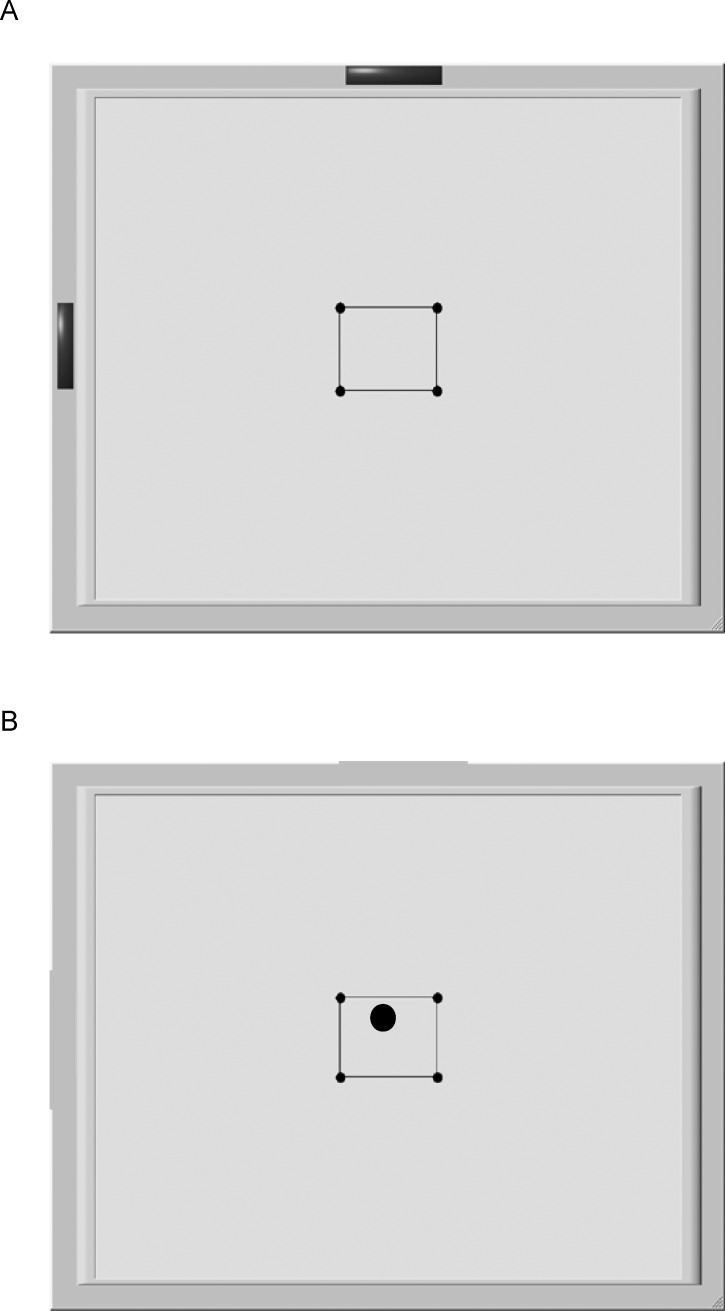Abstract
Context
Joint position sense (JPS) is a key neuromuscular factor for developing and maintaining control of muscles around a joint. It is important when performing specialized tasks, especially at the shoulder. No researchers have studied how Kinesio Tape (KT) application affects JPS.
Objective
To investigate the effects of KT application and no tape on shoulder JPS at increasing shoulder elevations in athletes.
Design
Cross-sectional study.
Setting
University laboratory.
Patients or Other Participants
A total of 27 healthy athletes who did not participate in overhead sports (age = 20.44 ± 1.05 years, height = 175.02 ± 11.67 cm, mass = 70.74 ± 9.65 kg) with no previous pathologic shoulder conditions volunteered for the study. All participants were from 1 university.
Intervention(s)
Shoulder JPS was assessed at increasing elevations with and without KT application. Participants attempted to actively replicate 3 target positions with and without the KT and without visual guidance.
Main Outcome Measure(s)
We examined absolute and variable repositioning errors at increasing shoulder-elevation levels with and without KT application.
Results
Data revealed an interaction between tape and position for absolute error (F2,52 = 4.07, P = .02); simple effects revealed an increase in error, with KT demonstrating a 2.65° increase in error at 90° of elevation compared with no tape (t26 = 2.65, P = .01). The effect size was medium (ω2 = .135). Variable error showed no interaction of tape and position (F2,52 = .709, P = .50). Further analysis of simple effects was not needed. However, we still calculated the effect size and observed small effect sizes for tape (ω2 = .002), position (ω2 = .072), and tape by position (ω2 = .027).
Conclusions
At 90° of elevation, shoulder JPS was impaired by the application of KT.
Key Words: proprioception, taping, shoulder, neuromuscular, rehabilitation
Key Points
Short-term Kinesio-Tape application to the shoulder reduced joint position sense acuity at 90° of elevation but did not affect JPS at 50° or 110°.
Kinesio Tape may negatively affect shoulder joint position sense, especially as the shoulder position approaches 90° of elevation.
Athletes, especially those who participate in overhead activities, place much stress on their shoulder joints during activity, so they are at increased risk for developing shoulder injuries. Given that the shoulder allows for much mobility, stability is sacrificed; therefore, the shoulder is considered one of the most vulnerable joints in the body.1 Numerous factors within the shoulder complex contribute to this lack of stability, including limited glenohumeral bony congruity, limited ligamentous support, and joint capsular laxity. However, stability is still needed to perform precise tasks for activities of daily living or sporting events.2 Factors that provide stability to the joint include support of surrounding muscles, the intra-articular pressure of the joint, and the integration of the central nervous system with peripheral mechanoreceptors, a sensory system termed proprioception.3
Proprioception is a specialized sensory capability that includes a person's sense of movement, joint position, and tension.4 Joint position sense (JPS) consists of both static and dynamic abilities to detect the position of the joint in space.5 Researchers6 have suggested that increased muscle activation leads to increased afferent feedback from muscle spindles, resulting in enhanced JPS. The JPS is enabled via sensory feedback from peripheral receptors in sites such as skin, muscles, ligaments, and tendons that the central nervous system processes, and JPS is a key factor for controlling joint movement.4
Investigators7 have observed that shoulder JPS improves as the shoulder-elevation angle approaches 90°. These results may indicate that as the elevation angle increases, the amount of gravitational torque increases, which increases muscle activation. Suprak et al7 hypothesized that this increase in muscle activation and the increase in activity from the musculotendinous mechanoreceptors contributed to improved JPS. Suprak et al8 supported these results, demonstrating that as resistance increased (via wrist weights) at a given shoulder position, shoulder repositioning error decreased. However, other authors5 have suggested that this effect of elevation on shoulder JPS may also be related to intrinsic factors of joint position, such as muscle-spindle and cutaneous-receptor activation.
Researchers9 believe the application of tape may improve proprioceptive abilities by increasing stimulation of cutaneous mechanoreceptors within the skin, which increases pressure on underlying muscles and, therefore, affects the joint's proprioception. Robbins et al10 reported that the application of ankle tape enhanced JPS when a person was on a surface with a slope greater than 10°. Traditional athletic tape can constrict joint range of motion (ROM) but can be a beneficial preventive measure; however, the integrity of the tape is not maintained for extended periods because of such extraneous factors as sweat, lotion, dirt, and hair. Therefore, the development of more specialized tapes that have longer-lasting effects and limit impairments has advanced in recent years. Effective tape application can last up to 1 to 2 days, and some of these specialty tapes can resist extraneous factors.
Kinesio Tape (KT; Kinesio Precut, Albuquerque, NM) is a specialized elastic tape that mimics the elasticity of skeletal muscle as it stretches up to 140% of its original length, allowing for no ROM restrictions.2,11 According to KT creator Kenzo Kase, it can strengthen an already weakened muscle by correcting the muscle's function, improving circulation of blood and lymph, decreasing pain, repositioning subluxed joints, and improving joint position and kinesthetic awareness.12 These effects allow the fascia and muscle to return to normal function by relieving the buildup of abnormal muscle tension and can improve joint function by increasing sensory mechanisms.11,13
The constant shear force produced by KT application against the skin leads to increased stimulation of the cutaneous mechanoreceptors.14 Murray14 observed an increase in electromyographic measurements after the application of KT to the thigh. He hypothesized that this increased mechanoreceptor activity would result in increased JPS acuity. His research also supported the claim that KT application to the thigh can improve active ROM of a joint compared with no tape.14 Murray14 asserted that KT can positively affect proprioception. However, other investigators11 have demonstrated no effect of KT application on the ability to actively replicate a passive ankle position. This discrepancy in observations warrants further investigation given the popularity of KT use in athletics and rehabilitation. No one has examined how KT affects shoulder JPS. Therefore, the purpose of our study was to assess the effects of KT application on shoulder JPS at increasing shoulder elevations in athletes. We hypothesized that the application of KT (1) would result in enhanced shoulder JPS at all elevation angles tested and (2) would not alter the effect of increased JPS acuity with elevation.
METHODS
Study Design
Analysis of shoulder JPS was performed using repeated measures with a crossover design. All participants were tested at various angles of shoulder elevation with KT and no tape.
Participants
Thirty athletes (12 men, 18 women) from the athletic training room at Western Washington University volunteered for this study. Volunteers were included if they had full shoulder ROM in scapular-plane elevation and no history of upper extremity or thoracic spine injury within the 6 months before the study. Participants who could not finish the testing were removed from the study. Data for 3 participants were eliminated from the study because of a previous shoulder injury that was not revealed until after the testing started, generalized joint laxity as assessed via the Beighton Hypermobility Scale with a score equal to or greater than 4, or technical problems with instrument calibration. A total of 27 participants (11 men, 16 women; age = 20.44 ± 1.05 years, height = 175.02 ± 11.67 cm, mass = 70.74 ± 9.65 kg) completed the study. All were involved in intercollegiate athletics: 6 in basketball, 9 in track and field (nonthrowing events), and 12 in soccer. In conjunction with their sport involvement, all participants performed resistance training from 2 to 5 days per week. For each participant, we tested the dominant upper extremity, defined as the extremity used to throw a ball (26 right, 1 left). All participants provided written informed consent, and the study was approved by the Western Washington University Institutional Review Board for the ethical treatment of human subjects.
Procedures
All testing was conducted in 1 session, which took approximately 1 hour, in a quiet room. Participants completed an injury history form that also included age, height, and mass (self-reported); upper extremity dominance; and current activity level. We assessed participants' hypermobililty using the Beighton Hypermobility Scale.15 Before testing, participants performed a warm-up, which consisted of dynamic movement and stretching. Dynamic movements consisted of upper extremity circles (clockwise and counterclockwise), Codman pendulum swings with 1.13 kg of external weight, and back-and-forth sagittal-plane upper extremity swings. Participants executed all dynamic movements for 1 set of 15 repetitions each. Passive stretching consisted of holding internal- and external- rotation positions while the shoulder was abducted to approximately 90°, overhead stretch, and adduction of the extremity across the chest. All stretches were held for 15 seconds and repeated twice. After the warm-up, we instructed participants to remove their shirt (women wore sports bras) and all jewelry, as these items may affect results by adding to tactile input.
Kinematic data were collected using the Fastrak 3-Space (Polhemus, Colchester, VT) magnetic tracking system. The Fastrak 3-Space unit consists of a transmitter, 3 receivers, and a digitizer. The transmitter emits several electromagnetic fields that are sensed by the receivers and digitizer. To track the movement of the humerus with respect to the thorax, we placed receivers on the sternum via double-sided and Micropore (3M; St Paul, MN) tape approximately 2.5 cm inferior to the jugular notch and on the humerus slightly superior to the lateral epicondyle. The humeral receiver was held in place by a custom-made molded cuff and hook-and-loop strap just superior to the lateral epicondyle. Another receiver was fastened to the acromion process of the scapula via double-sided tape for calibration purposes, but this receiver was removed before testing. The transmitter was positioned level to the thoracic receiver when the participant was seated (Figure 1).
Figure 1.
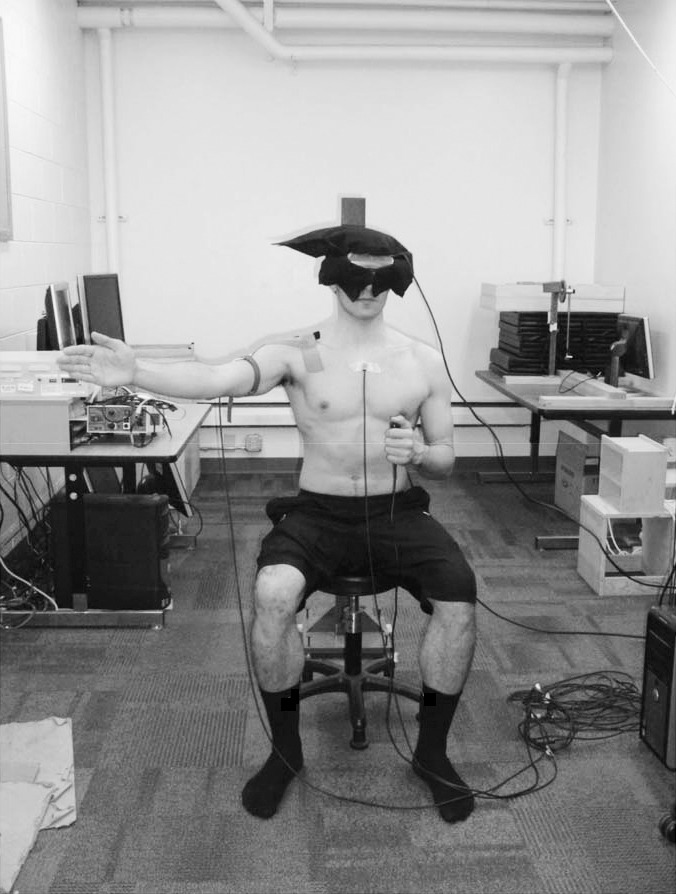
Experimental setup showing sensors, head-mounted display, and Kinesio Tape (Kinesio Precut, Albuquerque, NM).
After fixation of the receivers, several bony landmarks were digitized on the thorax, humerus, and scapula to establish an anatomical coordinate system in accordance with the standard endorsed by the International Society of Biomechanics.16 We used a least-squares algorithm to calculate the center of the humeral head, which was defined as the point that moved the least during a number of small motions.17 Euler angles were used to represent 2 sequence-dependent humeral rotations with respect to the thorax, consisting of plane of elevation and degree of elevation.18
Participants were fitted with adjustable head-mounted goggles to occlude all visual cues and to provide them with visual guidance during the presentation of the target position. The display screen within the goggles provided them with kinematic output from the computer. Thus, participants could view computer output with complete visual occlusion of shoulder movement and position (Figure 2).
Figure 2.
Computer output seen through the head-mounted display. A, guiding the participant to the target position and, B, with the shoulder in the target position.
After the instrumentation process and pretesting protocol, we instructed participants to sit on an adjustable stool with erect posture and alter the stool height so both feet were flat on the ground and knees were flexed to approximately 90°. When the seat was adjusted, we guided them through the testing procedure and allowed them to practice at least 4 additional trials until they were comfortable with the protocol. All practice trials were conducted in a position that corresponded to a plane of 45° anterior to the coronal plane and 45° of elevation, and practice occurred both with and without the head-mounted goggles so participants were comfortable with the testing procedures.
Of the 27 participants tested, 13 completed the no-tape condition first, and 14 completed the KT condition first. If the participant was randomly assigned to start with the KT condition, tape was applied after the practice trials. The test shoulder was cleaned thoroughly with alcohol and nonsterile gauze pads for both the KT and no-tape conditions. The participant was seated with the extremity in a relaxed position at the side. Prewrap or adhesive spray was not needed because the KT is applied directly to the skin and contains specialized glue. For this study, the precut Kinesio Tex Tape Gold (Kinesio Precut) for dynamic shoulder support was applied to the dominant extremity. Tape was applied according to manufacturer's instructions and consisted of a “Y” strip and 2 “I” strips (Figure 3).19
Figure 3.
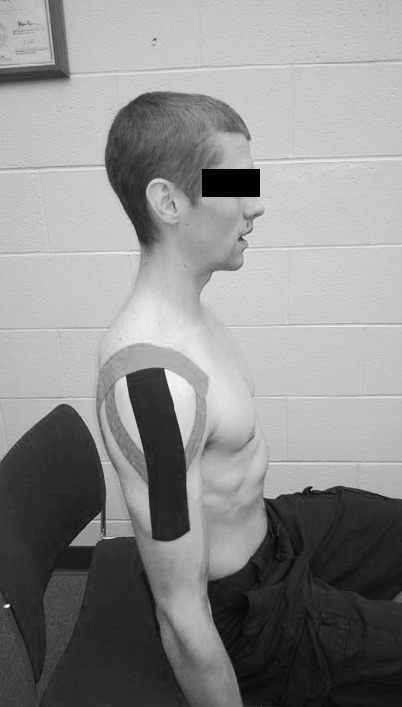
Kinesio-Tape application (Kinesio Precut, Albuquerque, NM).
All testing began with the extremity relaxed in a pronated position at the side. All extremity movements were performed with the elbow extended and the thumb side of the hand pointed upward (Figure 1). The screen that the participants saw was gray and had a black square in the center. On the 4 sides of the screen, red rectangular boxes directed the participant about how to move the extremity to achieve the target position. When participants moved to within 5° of the desired position, all rectangular boxes disappeared, and a red dot appeared on the screen. Participants continued to move the shoulder so the red dot appeared within the black square in the center of the screen, indicating that the shoulder had reached the target position. After holding that position for 1 second, they heard a beep, and the screen turned black and remained black for the remainder of the trial. Next, we instructed participants to maintain joint position for 5 seconds while concentrating only on the shoulder-joint position. When an oral command was given to “relax,” they returned the extremity to the side. After 3 seconds, we orally prompted participants to “return.” They then attempted to return to the target position, pushing a trigger with the contralateral hand after perceiving that they were in the target position. We instructed participants to maintain the position for 1 second after pressing the trigger until they heard a beep, which indicated the end of the trial.
Testing consisted of the 2 taping conditions (KT, no tape). The order of testing was selected randomly by flipping a coin, in which heads represented no tape and tails represented KT. Conditions were separated by a 10-minute break, which is slightly longer than the 3- and 5-minute breaks that previous authors11,20 have used to ensure that the lingering effects of tape application have dissipated. Within each condition, target positions consisted of elevation angles of 50°, 90°, and 110° (3 trials at each angle) in the scapular plane (35° anterior to the coronal plane). We chose these elevation angles for 2 reasons. First, many people with shoulder conditions, such as shoulder impingement and rotator cuff tears, report pain in shoulder elevation between 60° and 120°.21 Most of this ROM was represented by the elevation angles that we examined. Second, these elevation angles matched angles that other researchers have used to examine the effect of shoulder elevation on JPS,7 enabling comparison. All testing sequences and conditions were based on randomization via a balanced Latin-square design.
We converted the kinematic data into humeral-plane and elevation angles using transformation matrices between the coordinate systems of the humerus and thorax. Using these plane and elevation angles, we calculated 3-dimensional vectors as lines running from the center of the humeral head through the midpoint between the medial and lateral epicondyles at the presented and reproduced angles. The angle between the presented and reproduced position vectors was calculated for each trial and represented the absolute magnitude of the repositioning error, or absolute error (AE). We averaged the AE from each target position for each condition across the 3 trials and used the mean for further analysis. The variable error (VE) was calculated as the standard deviation of the AE at each position under each condition to determine the consistency of each participant's performance.
Statistical Analyses
We used two 2-way repeated-measures analyses of variance (ANOVAs) to evaluate the data. The first ANOVA was used to evaluate the effects of KT application (KT, no tape) and shoulder position (50°, 90°, 110°) on absolute repositioning error. The second ANOVA was used to evaluate these effects on variable repositioning error of the shoulder. We performed simple-effects analyses when we observed an interaction and pairwise comparisons when we observed main effects without an interaction. To quantify the standardized mean difference between the groups, the effect size was also calculated using the partial μ2 value, with the following convention: large (ω2 = .15), medium (ω2 = .06), or small (ω2 = .01) effect size.22 The α level was set at .05 based on the Mauchly sphericity test. Statistical analyses were performed using SPSS statistical software (version 20; IBM Corporation, Armonk, NY).
RESULTS
Absolute Error
The results of the Mauchly test indicated that sphericity was assumed (P = .49). The ANOVA revealed an interaction effect between tape and position for AE (F2,52 = 4.07, P = .02; Table 1, Figure 4). Given that we observed an interaction, we did not examine main effects of tape and position. However, further analyses of simple effects revealed an increase in error with KT, showing 2.65° greater error with the KT condition at 90° of elevation than the no-tape condition (t26 = 2.65, P = .01). We noted no other differences between the KT and no-tape conditions at 50° of elevation (t26 = 0.346, P = .73) or 110° of elevation (t26 = 0.546, P = .59). The application of KT increased the AE compared with the no-tape condition at 90° of elevation, and the effect size calculated using the Ω2 value was medium (ω2 = .135).
Table 1.
Joint Position Sense Absolute Error, ° (Mean ± SD)
| Shoulder Elevation, ° |
Condition |
|
| No Tape |
Kinesio Tape |
|
| 50 | 6.70 ± 3.50 | 6.50 ± 2.28 |
| 90 | 6.37 ± 3.16 | 7.89 ± 3.47 |
| 110 | 7.81 ± 2.86 | 7.47 ± 2.68 |
Figure 4.
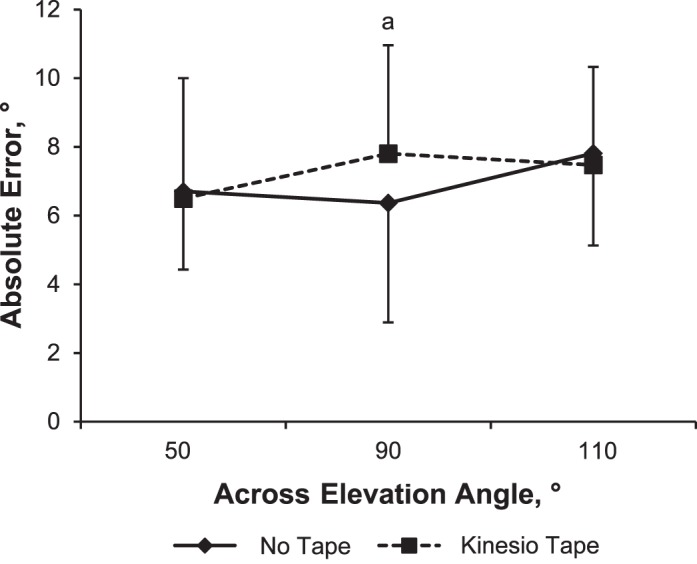
Absolute error across elevation angles for the 2 taping conditions. a Indicates difference between the tape and no-tape conditions.
Variable Error
The results of the Mauchly test indicated that sphericity was assumed (P = .44) for the analyses of VE. The ANOVA revealed no interaction of tape and position (F2,52 = 0.709, P = .50). We did not observe a main effect of tape (F1,26 = 0.045, P = .83) or position (F2,52 = 2.018, P = .14) on VE (Table 2, Figure 5). Given that we did not observe an interaction between tape and position, further analysis of simple effects was not needed. However, using the Ω2 method, we observed small effect sizes for tape by position (ω2 = .027), position (ω2 = .072), and tape (ω2 = .002).
Table 2.
Joint Position Sense Variable Error, ° (Mean ± SD)
| Shoulder Elevation, ° |
Condition |
|
| No Tape |
Kinesio Tape |
|
| 50 | 2.37 ± 1.36 | 2.22 ± 1.38 |
| 90 | 2.02 ± 1.30 | 2.27 ± 1.71 |
| 110 | 2.79 ± 1.26 | 2.53 ± 1.43 |
Figure 5.
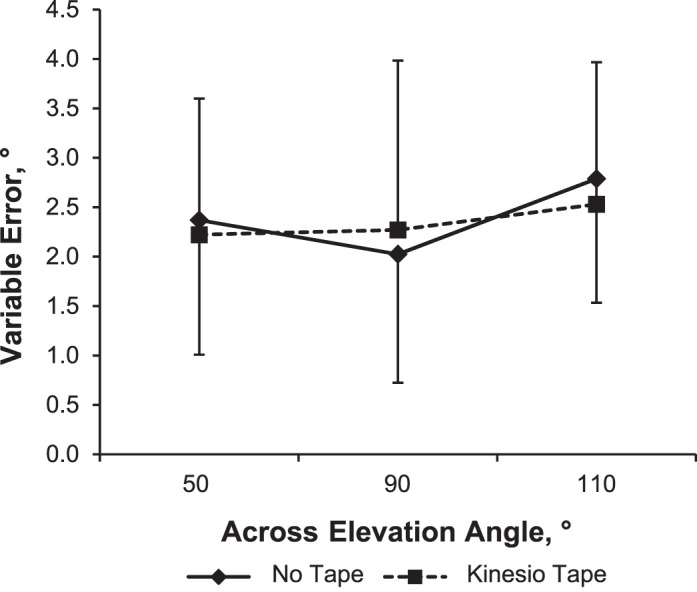
Variable error across elevation angles for the 2 taping conditions.
DISCUSSION
The purpose of our study was to assess the effects of KT application on shoulder JPS at increasing elevation angles within the scapular plane in athletes. As previously reported,11 KT application provides constant tension on the skin and increases cutaneous sensation. We hypothesized that shoulder JPS would be enhanced with KT application. Furthermore, based on the results of investigators7,8 examining JPS at increasing shoulder elevations and external torques, we hypothesized that shoulder JPS acuity would be enhanced with the application of KT at all elevation angles tested and that KT would not alter the effect of increased JPS acuity with elevation. These hypotheses were not supported with respect to AE or VE.
Our data indicated that KT application did not affect VE in the shoulder or AE at 50° and 110° of shoulder elevation but did increase error at 90° of elevation. To our knowledge, we are the first to investigate shoulder JPS with and without KT application. We did not observe an effect of KT application at 50° and 110° of shoulder elevation. This result is in agreement with previous findings at the ankle joint11 of no effect of KT application on ankle plantar-flexion and inversion AE or constant error. Whereas the study of JPS with KT application is still relatively new, investigators have found similar results for other neuromuscular-related variables. Researchers23,24 have reported that KT application does not affect single-hop or triple-hop distance or peak knee-extension torque.
Several possible explanations exist for our results. We applied 3 strips of KT to the shoulder with paper-off tension, meaning that no added stretch was applied after the paper backing was removed. According to the KT manufacturer, the paper-off tension is equivalent to approximately 10% stretch.13 However, when applying the “Y” strip around the upper arm, we placed the arm in approximately 45° of flexion for the anterior portion of the strip and roughly 45° of hyperextension for the posterior portion of the strip, whereas the remaining 2 “I” strips were applied with the arm in a neutral position (at the participant's side). Applying KT with paper-off tension would result in greater tension of the anterior strip at the neutral position and greater tension of the posterior strip as the shoulder was elevated. Given that the increased tension on the skin has been hypothesized to saturate cutaneous receptors25 and result in possible errors in interpretation of afferent signals by the central nervous system,26 the application of KT to the shoulder in this manner may detrimentally affect JPS. Our data suggested that this detriment, which may not have been noticeable at 50° of elevation, was amplified at 90° of elevation, where JPS acuity is normally highest.7 With the increasing elevations of the target positions, tension from the tape strips may have increased muscle activation27 and, therefore, increased γ motoneuron activation and muscle-spindle sensitivity.28,29 This change in mechanoreceptor sensitivity may have affected JPS acuity and may be responsible, at least in part, for the observed increase in error at 90° of elevation.
Our study had several limitations. First, we assessed only the short-term effects of KT application and shoulder-elevation angle on JPS. Therefore, more research is needed to examine the effect of extended KT application on shoulder JPS. Second, we tested only collegiate athletes who did not participate in overhead sports and had no previous injuries to the shoulder. Hence, our results may not represent findings that would be observed in participants with shoulder injuries and thus should be applied with caution to persons with musculoskeletal disorders. Third, we examined only the effects of tape applied with paper-off tension; greater levels of tape tension may have different effects on JPS.
Short-term KT application to the shoulder resulted in diminished JPS acuity at 90° of elevation but did not affect JPS at 50° or 110°. Therefore, KT may negatively affect shoulder JPS, especially as the shoulder position approaches 90° of elevation. However, given that we studied only healthy collegiate athletes who did not participate in overhead sports involving the shoulder, our study was limited in the following ways: (1) we could not determine the effects of KT application on persons involved in overhead sports, (2) we could not assess the effects of KT application in athletes with increased joint elasticity (instability) or injury, and (3) we could not compare the effects of KT application between sexes. Further research is needed to evaluate whether these results are consistent in athletes in overhead sports or persons with pathologic shoulder conditions. Despite the increase in error at 90°, the difference was small enough that it may not present a clinical risk. Therefore, KT application did not improve shoulder JPS. In addition, investigation into the effects of extended KT application on shoulder JPS may provide more insight into the efficacy of this treatment modality. Practitioners should be cognizant of these effects when considering whether to apply KT to the shoulder of a client for injury prevention, rehabilitation, or performance enhancement.
REFERENCES
- 1.Prentice WE. Essentials of Athletic Injury Management. 7th ed. Boston, MA: McGraw-Hill Higher Education; 2008. pp. 435–437. [Google Scholar]
- 2.Prentice WE, Arnheim DD. Arnheim's Principles of Athletic Training: A Competency-Based Approach. 14th ed. New York, NY: McGraw-Hill Higher Education; 2010. pp. 743–752. [Google Scholar]
- 3.Suprak D. Shoulder joint position sense is not enhanced at end range in an unconstrained task. Hum Mov Sci. 2011;30(3):424–435. doi: 10.1016/j.humov.2011.02.003. [DOI] [PubMed] [Google Scholar]
- 4.Lephart SM, Pincivero DM, Giraldo JL, Fu FH. The role of proprioception in the management and rehabilitation of athletic injuries. Am J Sports Med. 1997;25(1):130–137. doi: 10.1177/036354659702500126. [DOI] [PubMed] [Google Scholar]
- 5.Chapman J, Suprak DN, Karduna AR. Unconstrained shoulder joint position sense does not change with body orientation. J Orthop Res. 2009;27(7):885–890. doi: 10.1002/jor.20813. [DOI] [PubMed] [Google Scholar]
- 6.Voight ML, Hardin JA, Blackburn TA, Tippett S, Canner GC. The effects of muscle fatigue on and the relationship of arm dominance to shoulder proprioception. J Orthop Sports Phys Ther. 1996;23(6):348–352. doi: 10.2519/jospt.1996.23.6.348. [DOI] [PubMed] [Google Scholar]
- 7.Suprak DN, Osternig LR, Van Donkelaar P, Karduna AR. Shoulder joint position sense improves with elevation angle in a novel, unconstrained task. J Orthop Res. 2006;24(3):559–568. doi: 10.1002/jor.20095. [DOI] [PubMed] [Google Scholar]
- 8.Suprak DN, Osternig LR, Van Donkelaar P, Karduna AR. Shoulder joint position sense improves with external load. J Mot Behav. 2007;39(6):517–525. doi: 10.3200/JMBR.39.6.517-525. [DOI] [PubMed] [Google Scholar]
- 9.Drouin JL, McAlpine CT, Primak KA, Kissel J. The effects of kinesiotape on athletic-based performance outcomes in healthy, active individuals: a literature synthesis. J Can Chiropr Assoc. 2013;57(4):356–365. [PMC free article] [PubMed] [Google Scholar]
- 10.Robbins S, Waked E, Rappel R. Ankle taping improves proprioception before and after exercise in young men. Br J Sports Med. 1995;29(4):242–247. doi: 10.1136/bjsm.29.4.242. [DOI] [PMC free article] [PubMed] [Google Scholar]
- 11.Halseth T, McChesney JW, Debeliso M, Vaughn R, Lien J. The effects of Kinesio taping on proprioception at the ankle. J Sports Sci Med. 2004;3(1):1–7. [PMC free article] [PubMed] [Google Scholar]
- 12.Kinesio taping method. Kinesio Taping Association International Web site 2015 . http://www.kinesiotaping.com/about/kinesio-taping-method. Accessed February 25. [Google Scholar]
- 13.A brief history of Kinesio Tex taping. Authentic Kinesio UK Web site. 2015 http://www.kinesiotaping.co.uk/history.jsp. Accessed February 25. [Google Scholar]
- 14.Murray HM. Kinesiotaping, muscle strength and ROM after ACL repair. J Orthop Sports Phys Ther. 2000;30(1):A–14.. [Google Scholar]
- 15.Beighton P, De Paepe A, Steinmann B, Tsipouras P, Wenstrup RJ. Ehlers-Danlos syndromes: revised nosology, Villefranche, 1997. Am J Med Genet. 1998;77(1):31–37. doi: 10.1002/(sici)1096-8628(19980428)77:1<31::aid-ajmg8>3.0.co;2-o. [DOI] [PubMed] [Google Scholar]
- 16.Wu G, van der Helm FC, Veeger HE, et al. ISB recommendation on definitions of joint coordinate systems of various joints for the reporting of human joint motion, part II: shoulder, elbow, wrist and hand. J Biomech. 2005;38(5):981–992. doi: 10.1016/j.jbiomech.2004.05.042. [DOI] [PubMed] [Google Scholar]
- 17.Harryman DT, Sidles JA, Harris SL, Matsen FA. The role of the rotator interval capsule in passive motion and stability of the shoulder. J Bone Joint Surg Am. 1992;74(1):53–66. [PubMed] [Google Scholar]
- 18.An KN, Browne AO, Korinek S, Tanaka S, Morrey BF. Three-dimensional kinematics of glenohumeral elevation. J Orthop Res. 1991;9(1):143–149. doi: 10.1002/jor.1100090117. [DOI] [PubMed] [Google Scholar]
- 19.Shoulder precut application. Kinesio Precut Web site. 2015 http://www.kinesioproducts.com/index.php?option=com_content&view=article&id=10&Itemid=15&lang=en. Accessed February 26. [Google Scholar]
- 20.Hsu YH, Chen WY, Lin HC, Wang WT, Shih YF. The effects of taping on scapular kinematics and muscle performance in baseball players with shoulder impingement syndrome. J Electromyogr Kinesiol. 2009;19(6):1092–1099. doi: 10.1016/j.jelekin.2008.11.003. [DOI] [PubMed] [Google Scholar]
- 21.Xiao J, Cui GQ, Wang JQ. Diagnosis of bursal-side partial-thickness rotator cuff tears. Orthop Surg. 2010;2(4):260–265. doi: 10.1111/j.1757-7861.2010.00097.x. [DOI] [PMC free article] [PubMed] [Google Scholar]
- 22.Vincent WJ. Statistics in Kinesiology. 4th ed. Champaign, IL: Human Kinetics; 2005. p. 193. [Google Scholar]
- 23.Lins CA, Neto FL, Amorim AB, Macedo L, Brasileiro JS. Kinesio taping does not alter neuromuscular performance of femoral quadriceps or lower limb function in healthy subjects: randomized, blind, controlled, clinical trial. Man Ther. 2013;18(1):41–45. doi: 10.1016/j.math.2012.06.009. [DOI] [PubMed] [Google Scholar]
- 24.Fu TC, Wong AM, Pei YC, Wu KP, Chou SW, Lin YC. Effect of Kinesio taping on muscle strength in athletes: a pilot study. J Sci Med Sport. 2008;11(2):198–201. doi: 10.1016/j.jsams.2007.02.011. [DOI] [PubMed] [Google Scholar]
- 25.Janwantanakul P, Magarey ME, Jones MA, Dansie BR. Variation in shoulder position sense at mid and extreme range of motion. Arch Phys Med Rehabil. 2001;82(6):840–844. doi: 10.1053/apmr.2001.21865. [DOI] [PubMed] [Google Scholar]
- 26.Refshauge KM, Raymond J, Kilbreath SL, Pengel L, Heijnen I. The effect of ankle taping on detection of inversion-eversion movements in participants with recurrent ankle sprain. Am J Sports Med. 2009;37(2):371–375. doi: 10.1177/0363546508324309. [DOI] [PubMed] [Google Scholar]
- 27.Perlau R, Frank C, Fick G. The effect of elastic bandages on human knee proprioception in the uninjured population. Am J Sports Med. 1995;23(2):251–255. doi: 10.1177/036354659502300221. [DOI] [PubMed] [Google Scholar]
- 28.Jami L, Lan-Couton D, Petit J. Glycogen-depletion method of intrafusal distribution of gamma-axons that increase sensitivity of spindle secondary endings. J Neurophysiol. 1980;43(1):16–26. doi: 10.1152/jn.1980.43.1.16. [DOI] [PubMed] [Google Scholar]
- 29.Durbaba R, Taylor A, Ellaway PH, Rawlinson S. Modulation of primary afferent discharge by dynamic and static gamma motor axons in cat muscle spindles in relation to the intrafusal fibre types activated. J Physiol. 2001;532(pt 2):563–574. doi: 10.1111/j.1469-7793.2001.0563f.x. [DOI] [PMC free article] [PubMed] [Google Scholar]



